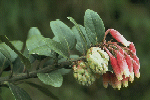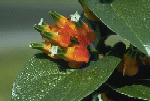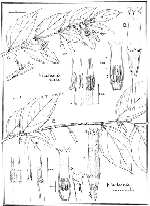- 8. Macleania W. J. HOOKER Icon. Pl. 2: pl. 109 (1837). -- Type: Macleania floribunda
HOOKER.
- Tyria KLOTZSCH, Linnaea 24: 21 (1851). -- Type: Tyria salapa (BENTHAM) KLOTZSCH
- [=Ceratostema salapa BENTHAM].
Reference: YEO, P., Notes on some species of Macleania
(Ericaceae). Baileya 15(2): 45--59 (1967).--LUTEYN, J.L., A review of and
taxonomic realignments within the neotropical genus Macleania
(Ericaceae:Vaccinieae). BioLlania 6:455--465 (1997).



Straggly to compact, epiphytic or terrestrial shrub. Leaves alternate, coriaceous,
pinnate or plinerved. Inflorescence axillary or terminal, racemose or subfasciculate
with few to many flowers, rarely flowers solitary. Flowers 5-merous, without odor;
aestivation valvate; calyx usually articulate with the pedicel, but this sometimes
obscure, rarely calyx continuous; hypanthium short- cylindric or campanulate, often
angled to conspicuously winged, the wings sometimes protruding beyond the calyx limb
as a spur; limb erect and spreading (3--4-) 5-lobed; lobes triangular, subacute;
corolla subcylindric or elongate urceolate, the lobes triangular, subacute, sometimes
spurred; stamen 10, equal, about one-quarter to nearly equalling the corolla in
overall length; filaments distinct or connate, dorsally attached to the anthers near their
bases, lacking spurs; anthers stout, lacking disintegration tissue; thecae strongly
granular; tubules about as long as the thecae, 1 (probably the result of total fushion from two) or 2 (then laterally connate or distinct, rarely completely distinct),
rigid, broadly conical, dehiscing by elongate, distinct or fused clefts; pollen
without viscin threads; ovary inferior; style filiform and about as long as the
corolla or longer, basally surrounded by an annular or cupuliform nectariferous disc. Fruit
a berry; seeds often with a mucilaginous sheath, the embryo sometimes green.
The genus Macleania
contains approximately 50 species which range from southern Mexico south along the
mountainous highlands into Peru. The center of diversity is western Ecuador.
Key to the Species of Macleania
- 1a.
- Stamen ca 1/2--1/4 the corolla length, the filaments connate, the anther tubules
fused to one with one dehiscence pore; calyx sharply angled and usually winged,
orangish; corolla angled to ribbed (rarely terete), orangish basally with green
throat and lobes, densely white pilose at throat and lobes within; mature berry translucent
white.
- 2a.
- Corolla > 30 mm long.
- 3a.
- Corolla, calyx, pedicel, and leaves beneath conspicuously scurffy with reddish-brown
glandular fimbriae; calyx continuous with pedicel, the lobes apiculate, to 1 mm
long; leaves usually bullate, the base acute to broadly cuneate-attenuate or rounded and short-attenuate; inflorescence a fascicle
- ..............................................................................M. bullata
- 3b.
- Flowers and leaves glabrous; calyx articulate, the lobes prominent, 1--2 mm long;
leaves flat, the base usually rounded and subcordate; inflorescence a short raceme
- ..............................................................................M. macrantha
- 2b.
- Corolla < 30 mm long.
- 4a.
- Inflorescence racemose, 0.3--3.4 (-7) cm long; calyx wings prominent from base
of hypanthium to tip of limb, then often elongated distally beyond limb margin as
spurs which are sometimes longer than the calyx lobes.
- 5a.
- Calyx wing spurs conspicuously longer than calyx lobes, sometimes 3--7 x 3 mm,
and conspicuously nerved; bracteoles usually medial to apical along pedicel; corolla
lobes never spurred; leaves subsessile, hardly petiolate, amplexicaul
- ...................................................................M. pentaptera
- 5b.
- Calyx wing spurs only slightly longer than calyx lobes, equal to lobes, or not
elongated beyond lobes; bracteoles apical or basal along pedicel; corolla lobes
sometimes spurred; leaves short-petiolate, clasping or amplexicaul.
- 6a.
- Bracteoles apical (subtending calyx) to subapical; leaves pinnately nerved, essentially
sessile and amplexicaul or clasping, or short-petiolate; inflorescence short-pilose
in some part; corolla lobes sometimes spurred.
- 7a.
- Corolla short-pilose, the lobes never spurred; calyx wing spurs usually equal
to or less than calyx lobe length; leaf bases rounded to cordate, subsessile or
rarely short-petiolate, clasping to amplexicaul; endemic to west-central Ecuador
(Pichincha south to Cañar)
- ..............................................M. rotundifolia
- 7b.
- Corolla usually glabrous but sometimes short-pilose, the lobes conspicuously spurred;
calyx wing spurs elongated beyond calyx lobes; leaf bases cordate, short-petiolate,
amplexicaul; northwest Ecuador (Esmaraldas and Lita, Imbabura) to Panama
- ..............................................M. smithiana
- 6b.
- Bracteoles basal; leaves plinerved and always short-petiolate; inflorescence
glabrous; corolla lobes never spurred.
- 8a.
- Corolla 15 mm long with thin diameter; calyx 4--5 mm long; inflorescence thin,
delicate; leaves elliptic to suborbicular, the base rounded not subcordate, the
surfaces not punctate, the margin often revolute; vicinity of Maldonado (Carchi
Prov.) at ca 1500 m altitude
- ..............................................M. maldonadensis
- 8b.
- Corolla 15--25 mm long with thick diameter; calyx 5.5--9 mm long; inflorescence
coarse, stout; leaves ovate to oblong- or elliptic-ovate, the base usually subcordate,
the surfaces punctate, the margin flat; widespread in W Ecuador at ca 1800--2500 m altitude
- ..............................................M. cordifolia
- 4b.
- Inflorescence fasciculate or flowers solitary; calyx wings usually not conspicuously
extended along the hypanthium or limb, not conspicuously elongated as spurs beyond
the limb or lobes (except somewhat in M. ericae
).
- 9a.
- Leaves pinnately nerved, the base rounded and deeply cordate, usually amplexicaul
- .....................................................................M. ericae
- 9b.
- Leaves usually plinerved (pinnately nerved in M. subsessilis
), the base rounded and sometimes subcordate or cuneate, petiolate not amplexicaul.
- 10a.
- Stem strongly and conspicuously winged, the wing to 3 mm broad
- ............................................................M. alata
- 10b.
- Stem terete to complanate, but not winged
- 11a.
- Leaves linear-lanceolate to narrowly ovate, 2.2-7 x 0.5--1.8 cm
- ....................................................M. dodsonii
- 11b.
- Leaves ovate-lanceolate to broadly ovate, 1.9--15 x 0.9--7 cm.
- 12a.
- Calyx usually covered with reddish-brown glandular fimbriae (these frequently
also on the pedicel and corolla); calyx hypanthium longer than broad and conspicuously
longer than the calyx limb, or shorter than the limb.
- 13a.
- Calyx limb essentially truncate, the lobes apiculate to none; corolla usually
short-pilose along length without and densely tomentose at throat within; leaves
plinerved; E Ecuador (Oriente)
- ............................M. floribunda
- 13b.
- Calyx limb with lobes conspicuous, 0.2--2 mm long; corolla glabrous without
and sparsely pilose at throat within; leaves pinnately nerved; NW Ecuador (Esmeraldas).
- 14a.
- Leaves (4-) 8--15 cm long, pinnately nerved; calyx 9--10 mm long, the hypanthium
2x longer than the limb; pedicels 2.5--4.5 mm long
- ...................M. subsessilis
- 14b.
- Leaves 1.8--9 cm long, plinerved; calyx 3.5--8 mm long, the hypanthium equal
to or half as long as the limb; pedicels 3--10 mm long
- ...................M. tropica
- 12b.
- Calyx hypanthium as long as broad, not conspicuously longer than the calyx limb;
calyx (pedicel and corolla) usually without glandular-fimbriae.
- 15a.
- Calyx lobes conspicuous, deltate, to 1 mm long; flowers in fascicles of 4--15;
corolla 14--20 mm long; leaves small, (2-) 4--8 (-11) x (1.3-) 2.5--4.5 (-6) cm
- ............................M. stricta
- 15b.
- Calyx lobes apiculate and less than 1 mm long, or nonexistent and calyx limb
truncate; flowers in fascicles of 1--3; corolla (16-) 23--25 mm long; leaves larger,
(3.5-) 7--14 (-17) x 2--7 (-9) cm
- ............................M. recumbens
- 1b.
- Stamen 1/2 to about equalling the corolla length, the filaments distinct, the
anther tubules two, usually laterally connate nearly to the apex, the tubules two
with two dehiscence pores; calyx essentially terete or pentagonal, only sharply
angled or winged in M. salapa
, reddish or greenish; corolla terete or pentagonal, only sharply angled in M. salapa
, red basally with white to yellowish-white tip and lobes, glabrous at throat within;
mature berry blue-black.
- 16a.
- Calyx sharply 5-angled (narrowly winged), the lobes elongate, narrowly triangular,
4--9 mm long; bracteoles with 2 circular, concave glands 0.2--0.3 mm diam. at base
- .......................................................................................M. salapa
- 16b.
- Calyx terete or bluntly pentagonal, the lobes short-deltate to apiculate, to
2 mm long; bracteoles without glands at base.
- 17a.
- Anther tubules about 1/2 as long as the thecae; leaves suborbicular
- ..............................................................................M. coccoloboides
- 17b.
- Anther tubules about equalling or slightly longer than the thecae; leaves variously-shaped
but not suborbicular.
- 18a.
- Inflorescence fasciculate, the rachis none.
- 19a.
- Leaves elliptic to obovate, broadest above the middle, the base rounded and short-attenuate
to cuneate-attenuate, the apex obtuse to rounded; inflorescence 4--8-flowered;
calyx hypanthium 10-ribbed; corolla 11--16 mm long; inflorescence densely farinose-pubescent
- ..........................................................M. farinosa
- 19b.
- Leaves ovate, broadest below the middle, the base usually rounded and subcordate,
the apex obtuse to acute; inflorescence 1--3-flowered; calyx hypanthium terete;
corolla 15--23 mm long; inflorescence short-pilose
- ..........................................................M. mollis
- 18b.
- Inflorescence racemose, the rachis short to long, 0.3--20 cm long.
- 20a.
- Bracts at base of inflorescence numerous, persistent, broadly oblong to broadly
ovate or narrowly triangular, 6--15 mm long.
- 21a.
- Calyx limb 5--7 mm long; rachis 3--14 (-24) cm long; inflorescence bracts oblong,
the apex rounded, 6--8 mm long; leaves essentially glabrous beneath; inflorescence
(including pedicel, calyx, and corolla) soft-pilose
- .................................................M. loeseneriana
- 21b.
- Calyx limb to 4 mm long; rachis 0.6--2.5 (-4) cm long; inflorescence bracts
broadly ovate with the apex rounded to short-acuminate or narrowly triangular with
the apex long acuminate, 6--15 mm long; leaves beneath and inflorescence glabrous
or pubescent.
- 22a.
- Inflorescence bracts narrowly triangular, long-acuminate, 8--15 mm long, the
tips often conspicuously reflexed
- ........................................M. benthamiana
- 22b.
- Inflorescence bracts broadly ovate, rounded to short-acuminate, usually less
than 6 mm long, the tips usually not reflexed
- ........................................M. rupestris
- 20b.
- Bracts at base of inflorescence few, deciduous, usually broadly ovate to ovate-deltate,
less than 4 mm long.
- 23a.
- Leaves oblong-obovate, long-attenuate at the base
- .................................................M. poortmannii
- 23b.
- Leaves ovate, elliptic, or oblong, rarely obovate, rounded to cuneate at the
base.
- 24a.
- Flowers and leaves persistently and densely short-hirsute; inflorescence (subfasciculate
?) to short-racemose, the rachis 0.3--0.5 cm long; corolla 10--14 mm long; leaves
mostly oblong-elliptic, 1--3 x 0.8--2 cm
- ........................................M. hirtiflora
- 24b.
- Flowers and leaves usually glabrous, or the corolla or leaves beneath sometimes
pilose but glabrate; inflorescence racemose, the rachis 1--1.5 cm long; corolla
13--19 mm long; leaves ovate, elliptic, or oblong, rarely obovate, 4--8 x 2--5 cm
- ........................................M. rupestris


